Hello my friends, welcome to the enchanting world of money plants in Feng Shui! As an experienced Feng Shui expert, I am thrilled to discover the transformative power that these vibrant green treasures can bring to any space.
With the ability to thrive in low-light conditions when grown indoors, the money tree is being widely promoted by many Feng Shui experts as a tool to boost positive energy flow in living spaces – thereby attracting abundance and prosperity.
But the wonders do not stop there! These notable plants also possess air-purifying qualities, making them a benefit to anyone seeking to create a healthier and more balanced environment. And with their versatility in placement, they can beautify almost any nook and cranny, infusing the surrounding environment with added vitality.
Therefore, as a Feng Shui expert, Phung Phuong, I will share with you what money plants are, why they are used in Feng Shui, and how to harness their power to create harmony and prosperity in your life.
What are money plants?

I am delighted to shed some light on the secrets behind the auspicious symbol of money plant. Perhaps you already know that in the world of Feng Shui, the money tree is considered a powerful tool to tap into Chi or Qi (energy) for wealth and success.
In fact, the common name “money plant” or “money tree” is used for dozens of different plant species from all over the world. These plants are given this name for various reasons, such as plants with coin-shaped leaves, plants with hands reaching up to receive money, or plants associated with symbols of wealth and prosperity.
Many believe that growing a money plant indoors can bring luck, riches, and favorable business opportunities. According to Feng Shui principles, money plants belongs to the Wood element, where plants live and grow in the Earth element, with Water as its nourishment.
Some even add lucky symbols such as red ribbons, red money bags, or gold coins, which symbolize the Fire and Metal elements. This decoration enhances the auspicious energy for the plant and helps it to harmonize with all the necessary Five Elements.
In summary, my dear Feng Shui enthusiasts, by nurturing your money plants and placing them in strategic areas within your home, you can harness the power of this attractive plant to attract wealth and success.
Why are plants used in Feng Shui?

To be honest, for Feng Shui practitioners like myself, using plants to bring positive energy, balance, and harmony to a space is quite common. Not only do they enhance the aesthetic appeal of a space, making it more attractive and comfortable, but they also bring many benefits in many other aspects such as:
Connecting with nature: Incorporating plants into a space helps establish a connection with nature, which is a fundamental principle in Feng Shui. This connection can create a sense of peace and tranquility, promote relaxation, and reduce stress.
Positive energy: Plants are considered living beings that emit positive energy. They can be used to balance and improve the flow of chi or energy in a space.
Air purification: Green plants can improve indoor air quality by removing pollutants and producing oxygen, contributing to a healthier living environment.
Enhancing specific areas: In Feng Shui, different plant types are associated with specific aspects of life, such as wealth, love, health, and career. By placing certain types of plants in specific areas (called “bagua” areas) of a space, they can enhance those aspects of life.
Balancing the elements: Feng Shui is based on the balance of the five elements – wood, fire, earth, metal, and water. Plants, as part of the wood element, can be used to create a harmonious balance among these elements in a space.
Overall, we use plants in Feng Shui because they help bring positive energy, create balance, and promote a healthier, more harmonious living environment.
10 Popular money plants used in Feng Shui
Below are 10 types of money plants that I often recommend to my clients to grow indoors to attract wealth, luck, and positive energy.
1. Jade Plant (Crassula ovata)
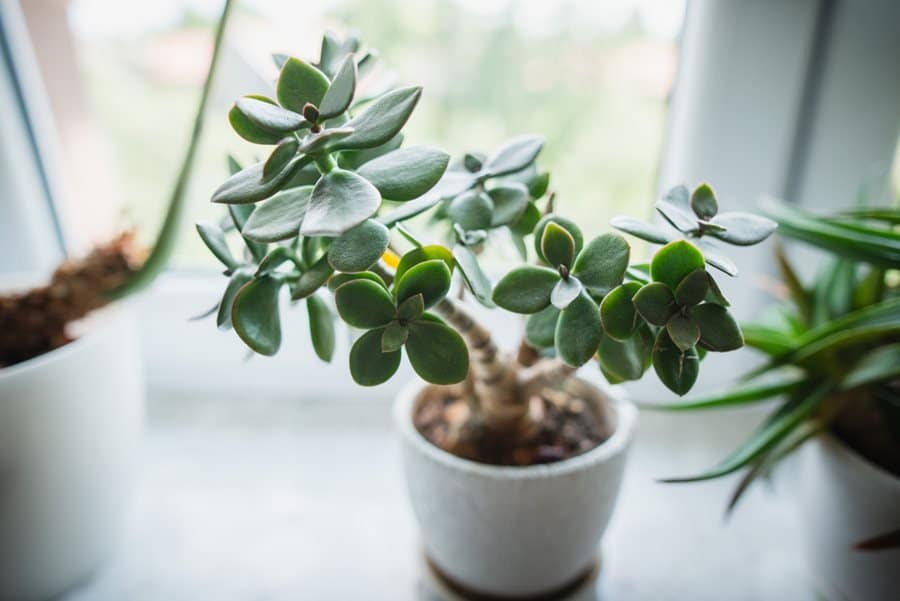
The Jade Plant (Crassula ovata) is truly a gem in the world of Feng Shui! I am always amazed at the incredible energy this succulent plant brings to a space, time and time again in my projects.
The Jade Plant, also known as the Money Plant or Friendship Tree, is native to South Africa and features plump, oval-shaped leaves that resemble jade stones. This evergreen succulent is popular not only for its low maintenance and aesthetic appeal but also for the auspicious energy it emits.
In Feng Shui, the Jade Plant is revered as a symbol of prosperity, luck, and abundance. Its succulent leaves represent the accumulation of wealth and the preservation of resources. Many believe that having a Jade Plant can attract financial blessings and strengthen relationships.
When it comes to placement, the Jade Plant thrives in the Wealth and Prosperity area of your home or office. This area, typically found in the back left corner of a space, is associated with the Wood element. Since the Jade Plant is a symbol of the Wood element, it naturally enhances and nourishes the energy of this area. You can also place it near the entrance as a warm welcome to positive energy and luck.
To maximize its benefits, it’s important to care for your Jade Plant properly. Make sure it receives enough sunlight (but not too much) and water sparingly to avoid root rot. As the saying goes, “A healthy plant equals a healthy flow of chi.”
In addition to proper placement and care, the Jade Plant is often decorated with red ribbons, gold coins, or other lucky charms to amplify its energy. This is especially common during Chinese New Year when households hope to attract a prosperous year.
2. Pachira Aquatica (Money Tree)
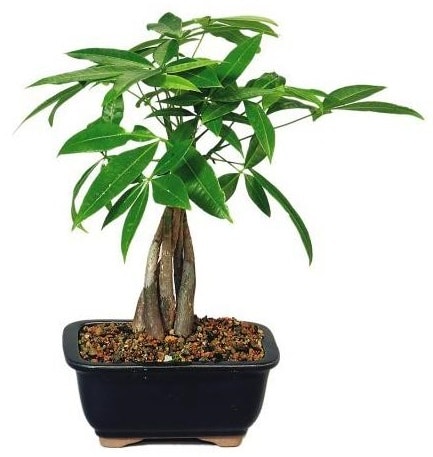
Pachira Aquatica, commonly known as the Money Tree, is a true powerhouse in the world of Feng Shui! Originating from Central and South America, this attractive plant is characterized by its braided trunk and lush green foliage. This indoor-friendly plant has gained popularity not only for its aesthetic appeal but also for the positive energy it emanates.
In Feng Shui, the Money Tree is highly regarded as a symbol of wealth, luck, and abundance. Its unique braided trunk represents the interweaving of the five basic elements – wood, fire, earth, metal, and water – working harmoniously to create positive energy.
Like other money plants, I still advise my clients to place the Pachira Aquatica in a wealthy area. But to determine the exact area, you will need a Bagua map and the advice of a professional Feng Shui expert.
Proper care is necessary to fully harness the potential of your Money Tree. Make sure it receives indirect sunlight, as direct sunlight can scorch the leaves. Water it moderately, allowing the soil to slightly dry out between watering to avoid root rot. Remember, “A well-grown plant will attract luck and prosperity.”
3. Golden Pothos (Epipremnum aureum)
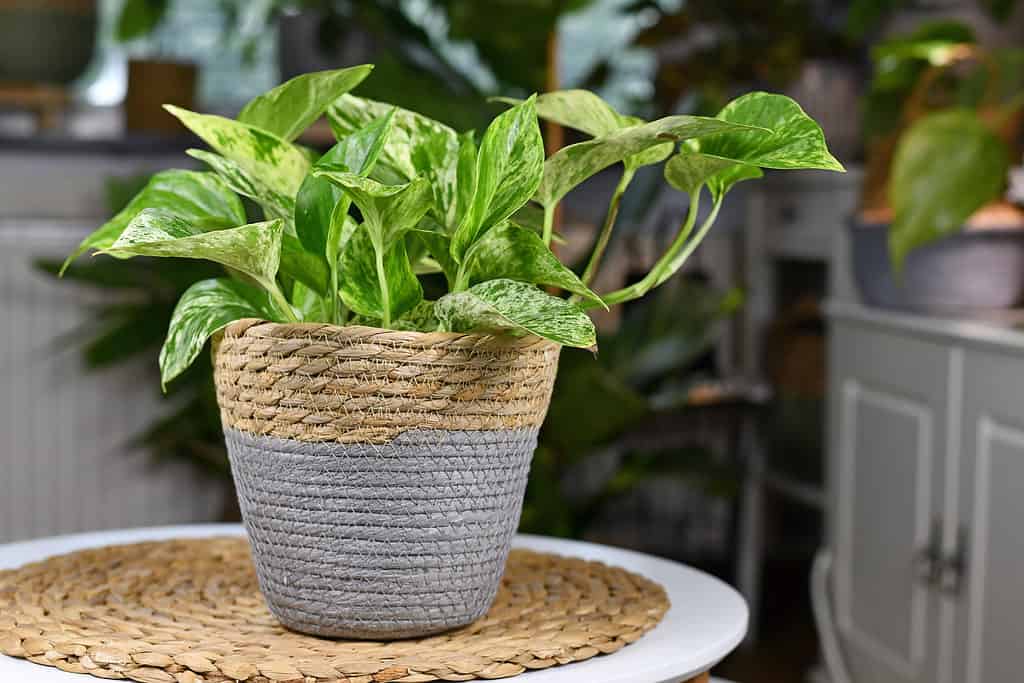
The Golden Pothos (Epipremnum aureum) is a truly versatile gem in the realm of Feng Shui! Golden Pothos, also known as Devil’s Ivy or Money Plant, is a popular indoor plant native to the Solomon Islands. It is characterized by its heart-shaped leaves with splashes of yellow or white, and is well-loved for its ability to purify the air and adapt to various lighting conditions.
In the realm of Feng Shui, Golden Pothos is highly valued for its ability to regenerate energy within a space. It is known to promote a sense of calm, improve overall well-being, and foster a healthy environment. The plant’s cascading vines symbolize growth, expansion, and the free flow of positive energy.
When it comes to placement, we often place a pot of Golden Pothos in the Family and Health area to encourage health, vitality, and harmonious relationships. Additionally, the plant can be placed in the Knowledge and Self-Cultivation gua to stimulate personal growth and intellectual development.
Golden Pothos can also be used as a natural air purifier, making it an excellent choice for rooms with limited ventilation or places prone to energy stagnation. Its ability to filter toxins in the air helps to make the air cleaner and more energetic.
To ensure your Golden Pothos plant thrives, provide it with indirect sunlight and water it moderately, allowing the soil to slightly dry out between waterings. If you want to rejuvenate positive energy flow and nurture a sense of calm in your life, own a Golden Pothos plant in your home.
4. Lucky Bamboo (Dracaena sanderiana)

Lucky Bamboo (Dracaena sanderiana) is a popular Money Plant used in Asia! Although its name is Lucky Bamboo, it is not actually a type of bamboo but a member of the Dracaena family. This prominent plant, originating from Central Africa, is characterized by its slender stem, green color, and vibrant leaves. It has become widely popular not only for its elegant appearance but also for the positive energy it radiates.
In Feng Shui, Lucky Bamboo is highly valued as a symbol of prosperity, luck, and resilience. Its strong, upright growth represents stability and power, while the number of stems arranged together holds specific meanings. For example, three stems symbolize happiness, wealth, and longevity, while five stems represent the five elements – wood, fire, earth, metal, and water.
When it comes to placement, Lucky Bamboo is quite versatile. It can be placed in the Wealth and Prosperity area to attract abundance and success. Additionally, it can be placed in the Family and Health area, located in the center left, to promote harmony and happiness.
Lucky Bamboo is often grown in water or soil and prefers indirect sunlight. To maintain a healthy plant, be sure to change the water frequently and keep the leaves dust-free. An Asian proverb states: “A flourishing plant nurtures a flourishing energy.”
To enhance its energy even more, you can decorate your Lucky Bamboo plant with red ribbons or other lucky charms, especially during festive occasions such as the Lunar New Year, when families hope to open up a prosperous year ahead.
5. Chinese Money Plant (Pilea peperomioides)
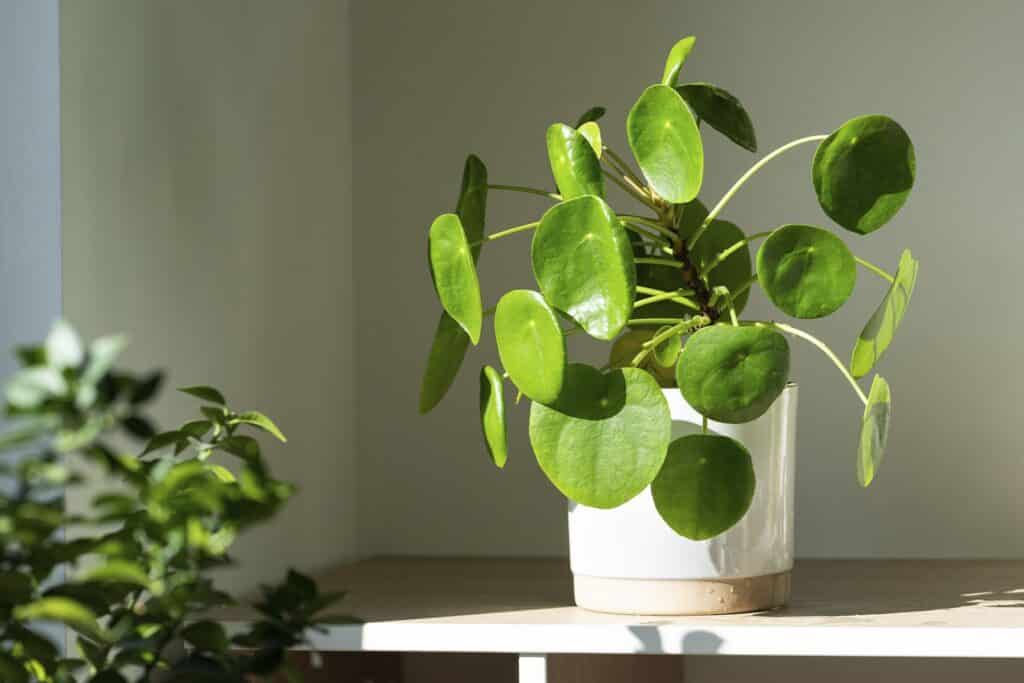
There is no doubt that Chinese Money Plant (Pilea peperomioides) is a true symbol of prosperity in Feng Shui! As a Feng Shui expert, I am honored to share the benefits of this plant with you.
The Chinese Money Plant is native to Yunnan Province, China and is characterized by its round, dark green leaves, resembling coins. Each leaf has a diameter of approximately 10cm and grows on a long stem. In low light conditions, the leaves at the base of the plant will gradually fall off. The plant can grow up to 30cm tall when grown indoors and up to 45cm under favorable conditions.
This indoor plant is popular not only for its aesthetic appeal but also for its ability to attract money and wealth into your home.
In Feng Shui, the Chinese Money Plant is revered for its ability to attract wealth, luck, and abundance. It represents luck, happiness, and prosperity. Its coin-like leaves and evergreen color symbolize vitality, bringing a sense of comfort to the home and warding off work-related stress.
When it comes to placement, aside from Wealth area, you can place the Chinese Money Plant in the Creativity and Children area, located in the middle right of the house to encourage imagination, personal growth, and a sense of joy.
The Chinese Money Plant is a low-maintenance plant. All you need to do is to let it “sunbathe” regularly as it is a light-loving plant. Therefore, although it is an indoor plant, you should take it outside to bask in the sun on the balcony or in the garden.
The Chinese Money Plant thrives in good soil conditions, but it can still grow in most types of soil as long as the soil can drain water properly.
Moreover, the Pilea peperomioides plant also has air-purifying properties. According to NASA’s research, this plant has the ability to remove harmful substances in the air such as formaldehyde, toluene, and benzene. Therefore, planting a Pilea peperomioides plant will help make the air in your home cleaner and healthier.
6. Rubber Plant (Ficus elastica)
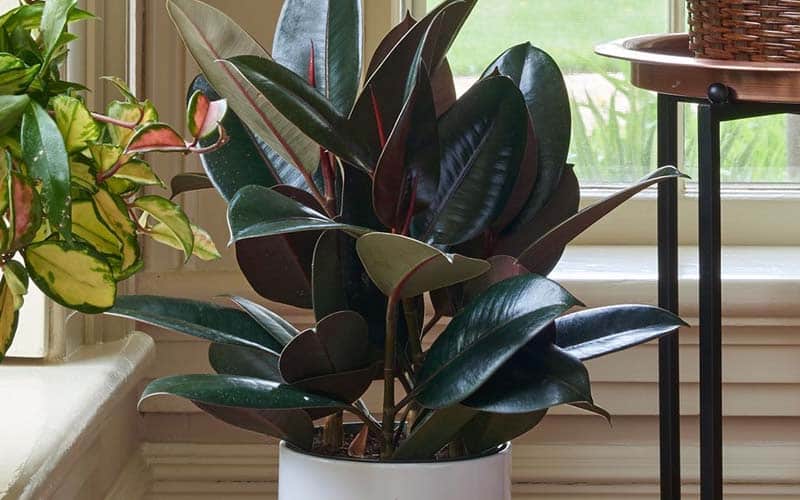
The Rubber Tree Plant (Ficus elastica) is truly a standout in the realm of Feng Shui! The Rubber Plant, native to Southeast Asia, is characterized by its large, glossy green leaves and a healthy, robust appearance. It is a popular indoor plant for many households due to the numerous benefits it offers.
In Feng Shui, the Rubber Tree is highly regarded for its ability to balance energy and promote a sense of stability in the space. It represents growth, prosperity, and resilience. Additionally, its air-purifying qualities contribute to creating a healthier and revitalizing environment.
Rubber Plant’s eye-catching color brings a lively and cheerful atmosphere to living spaces, making it a popular decorative plant. You can grow Rubber Plant as an interior plant for your workspace, restaurants, hotels, cafes, or as a mini pot for your desk or cashier’s counter to attract money.
Rubber Plant has the ability to absorb dust and toxic gases such as carbon monoxide, hydrogen fluoride, and even cigarette smoke in the air. Therefore, if you grow Rubber Plant indoors, it is extremely beneficial for your family’s health.
For a long time, Ficus Elastica has been a symbol of survival, resilience, containing the spirit and spirituality of humans. In Vietnam, Rubber Tree is often grown at the entrance of a village as a protective deity for all living things, bringing peace to every household.
That’s why in Feng Shui, Rubber Tree also represents good luck and peace. Growing this plant in your home is like having a protective shield. If grown on a workspace desk, it helps the owner’s work run smoothly and successfully. With its bud and leaf colors, Rubber Plant is suitable for people with Fire and Earth elements in their birth chart. Those people who grow Rubber Plant will always have a smooth and successful life and career.
Like other money plants, you can place the Rubber Tree in a wealth area or near the entrance to attract wealth into the house.
In sum, the Rubber Plant is a valuable addition for those seeking to nurture positive energy flow and cultivate a sense of stability in their lives.
7. ZZ Plant (Zamioculcas zamiifolia)
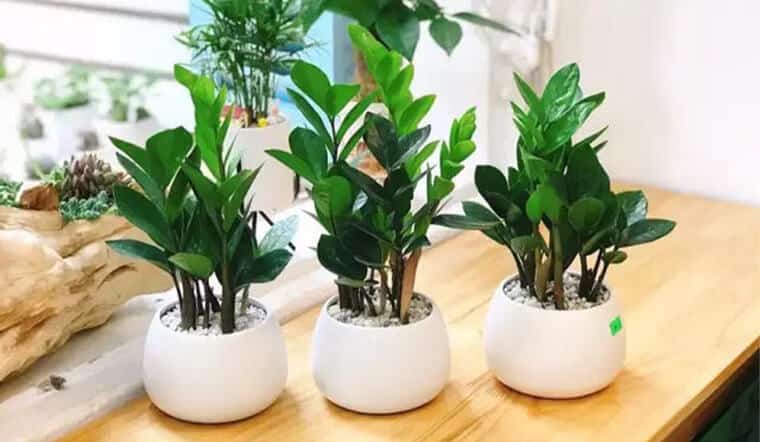
The ZZ Plant (Zamioculcas zamiifolia) is truly a gem in the world of Feng Shui! Originating from East Africa, the ZZ Plant is characterized by its shiny, dark green leaves and its upright, sturdy stems. This low-maintenance indoor plant is highly valued not only for its aesthetic appeal but also for its air-purifying properties and ability to create a harmonious atmosphere.
In the realm of Feng Shui, the ZZ Plant is honored for its ability to attract and enhance positive energy in a space. It represents growth, abundance, and resilience. Fun fact: the ZZ Plant is the most commonly grown money plant in my beloved country of Vietnam because its leaves resemble hands reaching out to receive wealth.
When it comes to placement, the ZZ Plant is very adaptable and can thrive in various locations throughout your home. However, to ensure your ZZ Plant thrives, provide it with indirect sunlight ranging from low to medium and water sparingly, allowing the soil to dry out between watering to prevent root rot.
8. Peace Lily (Spathiphyllum)

Peace Lily (Spathiphyllum) is a true beacon of tranquility in the world of Feng Shui! Peace Lily originates from tropical regions of the Americas and is characterized by its dark green, shiny leaves and unique white flowers that resemble a white peace flag.
Peace Lily is a herbaceous plant that grows into a bush with many plants close together. Its leaves are large, ranging from 3 to 25 cm wide, with a long stem of 12 to 65 cm. The leaves grow from the ground and have an oval shape, with a tendency to droop toward the root.
In Feng Shui, Peace Lily is revered for its ability to cleanse and balance energy in a space. It represents peace, harmony, and spiritual growth. In addition, its air-cleansing properties contribute to a healthier and more vibrant environment.
In modern society, people are constantly exposed to radiation and electromagnetic fields. Every cell in the body is affected by this, and Peace Lily is an excellent tool for mitigating these effects. Spathiphyllum also balances the air field by absorbing sources of negative energy in the house, helping to balance the body against artificial radiation fields emitted by electronic devices such as computers, radios, clocks, microwaves, telephones, and televisions. Therefore, it is recommended to place the plant near these devices to neutralize the living environment.
The plant can filter benzene VOC, a cancer-causing substance found in paint, polish, and interior waxes. It also has the ability to neutralize acetone, formaldehyde, and trichloroethylene, which are emitted by electronic devices, adhesives, and cleaning agents. Therefore, Peace Lily is also good for people with conditions such as insomnia, fatigue, acute and chronic diseases by promoting relaxation, creating a peaceful and harmonious space.
You may wonder why Peace Lily is classified as a money plant, right? It’s because its flower symbolizes the funnel to collect wealth.
9. Spider Plant (Chlorophytum comosum)

Spider Plant (Chlorophytum comosum) originates from tropical and southern Africa, characterized by its long, slender leaves and graceful, curving growth. This indoor plant is widely cultivated in the homes of wealthy families in Asia, even though it does not have a flashy and prominent appearance.
In the field of Feng Shui, Spider Plant is admired for its ability to purify and add positive energy to a space. It represents growth, adaptability, and the free flow of positive energy. According to Feng Shui experts, Spider Plant is a symbol of resilience, perseverance, and strength, able to withstand challenges and difficulties in life.
In addition, Spider Plant can help ward off negative energy and spirits. Chlorophytum comosum is considered a magical talisman, not only bringing peace and happiness to the family but also bringing luck and prosperity in their career.
Furthermore, this plant has a strong air-purifying ability and can absorb harmful toxins like formaldehyde in the air. Therefore, many newly renovated homes will choose to plant a few pots of Spider Plant indoors to purify the air.
Spider Plant is also able to withstand certain levels of drought. During the spring and fall, when the soil surface is dry, you can water it more. In the summer, due to high temperatures and evaporation, you should water it more moderately. During the winter, when the temperature drops and the plant grows slowly, you should reduce the amount of water accordingly.
10. Snake Plant (Sansevieria)

Snake Plant (Sansevieria) is considered a talisman of luck and fortune in the world of Feng Shui! Snake Plant, originating from West Africa, is characterized by tall, upright leaves that resemble swords with prominent and diverse patterns.
Snake Plant is a type of money plant that has excellent Feng Shui values. The plant will bring luck and wealth to the owner’s family and career success. Therefore, they are often placed in office spaces or homes as a tool to create good Feng Shui.
This is also a rare flowering plant, so when it blooms, it has a very special meaning. When Snake Plant flowers and bears fruit, it is a sign of good luck and fortune coming your way. Fun fact: in Vietnam, it is called “Tiger’s Tongue Plant” due to the yellow-striped leaf shape resembling a tiger’s tongue. Therefore, this money plant is also considered a talisman to ward off evil spirits and negative energy, attracting wealth and good luck.
Moreover, Snake Plant is ranked among the top 10 plants with the best air purifying abilities. The process of photosynthesis and metabolic exchange of the plant will gather various air pollutants and supply pure oxygen to improve human health.
Due to its superior air purification ability, Snake Plant is also known as a “natural air purifying machine”. One pot of Snake Plant in the house can absorb harmful gases such as sulfur dioxide, chlorine, ether, ethylene, carbon monoxide, and nitrogen peroxide.
In terms of care, it is best to choose sandy soil to plant Snake Plant when the root system has not yet developed. Sandy soil usually contains less nutrients, so you can add matured organic fertilizer and compost to the sandy soil when planting Snake Plant.
5 Easy ideas for growing a bushy money plant indoors
This video will guide you on how to plant and care for money plants to help them thrive when grown indoors. From light and temperature to fertilizing and pruning techniques to make them bushy. This will create an interesting focal point in your space and invite positive energy into your home.
So, above are useful information about money plants and 10 types of money trees that feng shui expert Phung Phuong often recommends her clients to grow indoors to bring luck and attract wealth. However, LotusBuddhas advises that you should only choose plants that are suitable for your living space and environment. This will allow them to grow well, thereby contributing to creating a better energy flow and overall harmony in your space.





